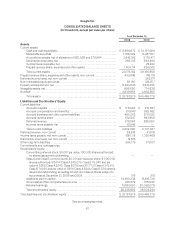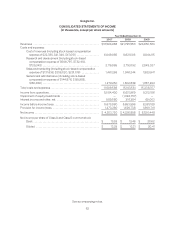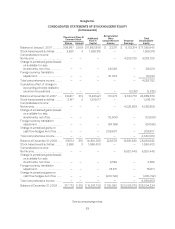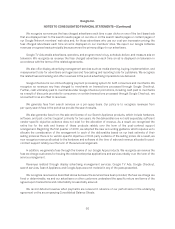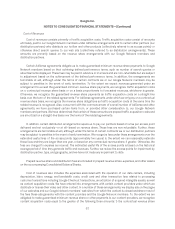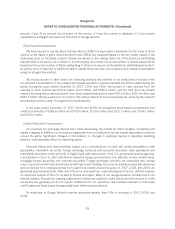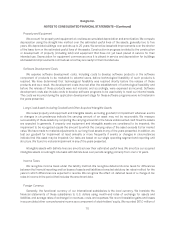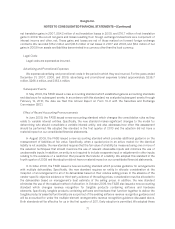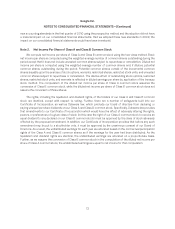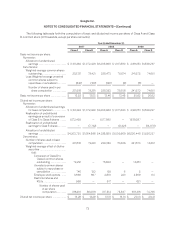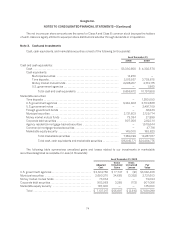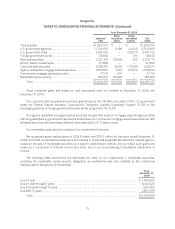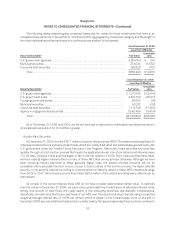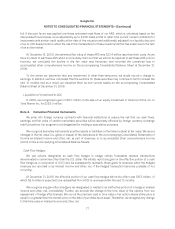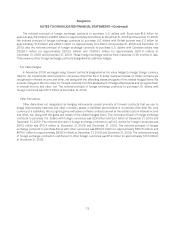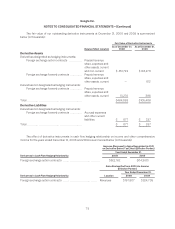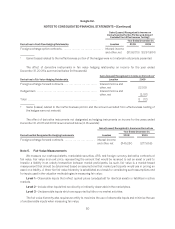Google 2009 Annual Report Download - page 89
Download and view the complete annual report
Please find page 89 of the 2009 Google annual report below. You can navigate through the pages in the report by either clicking on the pages listed below, or by using the keyword search tool below to find specific information within the annual report.Google Inc.
NOTES TO CONSOLIDATED FINANCIAL STATEMENTS—(Continued)
net translation gains in 2007, $84.2 million of net translation losses in 2008, and $76.7 million of net translation
gains in 2009. We record net gains and losses resulting from foreign exchange transactions as a component of
interest income and other, net. These gains and losses are net of those realized on forward foreign exchange
contracts. We recorded $16.2 million and $35.6 million of net losses in 2007 and 2008, and $8.2 million of net
gains in 2009 from assets and liabilities denominated in a currency other than the local currency.
Legal Costs
Legal costs are expensed as incurred.
Advertising and Promotional Expenses
We expense advertising and promotional costs in the period in which they are incurred. For the years ended
December 31, 2007, 2008, and 2009, advertising and promotional expenses totaled approximately $236.7
million, $266.4 million, and $353.4 million.
Subsequent Events
In May 2009, the FASB issued a new accounting standard which established general accounting standards
and disclosure for subsequent events. In accordance with this standard, we evaluated subsequent events through
February 12, 2010, the date we filed this Annual Report on Form 10-K with the Securities and Exchange
Commission (SEC).
Effect of Recent Accounting Pronouncements
In June 2009, the FASB issued a new accounting standard which changes the consolidation rules as they
relate to variable interest entities. Specifically, the new standard makes significant changes to the model for
determining who should consolidate a variable interest entity, and also addresses how often this assessment
should be performed. We adopted this standard in the first quarter of 2010 and the adoption did not have a
material impact on our consolidated financial statements.
In August 2009, the FASB issued a new accounting standard which provides additional guidance on the
measurement of liabilities at fair value. Specifically, when a quoted price in an active market for the identical
liability is not available, the new standard requires that the fair value of a liability be measured using one or more of
the valuation techniques that should maximize the use of relevant observable inputs and minimize the use of
unobservable inputs. In addition, an entity is not required to include a separate input or adjustment to other inputs
relating to the existence of a restriction that prevents the transfer of a liability. We adopted this standard in the
fourth quarter of 2009 and the adoption did not have a material impact on our consolidated financial statements.
In October 2009, the FASB issued a new accounting standard which provides guidance for arrangements
with multiple deliverables. Specifically, the new standard requires an entity to allocate consideration at the
inception of an arrangement to all of its deliverables based on their relative selling prices. In the absence of the
vendor-specific objective evidence or third-party evidence of the selling prices, consideration must be allocated to
the deliverables based on management’s best estimate of the selling prices. In addition, the new standard
eliminates the use of the residual method of allocation. In October 2009, the FASB also issued a new accounting
standard which changes revenue recognition for tangible products containing software and hardware
elements. Specifically, tangible products containing software and hardware that function together to deliver the
tangible products’ essential functionality are scoped out of the existing software revenue recognition guidance and
will be accounted for under the multiple-element arrangements revenue recognition guidance discussed above.
Both standards will be effective for us in the first quarter of 2011. Early adoption is permitted. We adopted these
71


